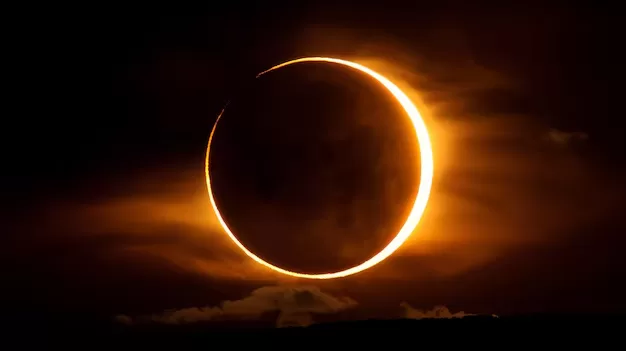Overview: Annular Solar Eclipse 2024
On October 2, 2024, a spectacular annular solar eclipse will take place, visible from the Pacific Ocean, southern Chile, and southern Argentina. During this event, the moon will pass in front of the sun, but because it will be farther from Earth than during a total solar eclipse, it won’t completely block the sun’s light. This creates the stunning “ring of fire” effect, which occurs when a bright ring of sunlight surrounds the dark silhouette of the moon.

At the point of maximum eclipse over the Pacific, the moon will obscure about 93% of the sun, leading to a breathtaking view that will last approximately 7 minutes and 25 seconds.
To stay updated on this astronomical event, follow our live blog, and don’t miss our livestream of the eclipse on Space.com, hosted in partnership with TimeandDate.
Safety Precautions
It’s essential to emphasize that viewing the sun directly without specialized solar eclipse glasses is never safe. Always refer to our safety guidelines to protect your eyes.
Understanding an Annular Solar Eclipse
The upcoming eclipse is similar to the annular solar eclipse that occurred on October 14, 2023, which was visible in parts of the U.S. Southwest and across Central and South America. An annular solar eclipse occurs when a new moon is perfectly aligned between Earth and the sun, but at a greater distance. Thus, while the moon appears to cover the sun, it leaves a ring of sunlight visible around its edges.
This particular eclipse will have a magnitude of 0.9326, meaning approximately 93% of the sun will be obscured, creating a prominent annular effect. Additionally, the moon will appear 6.4% smaller than average.
Where to View the Eclipse
The ring of fire will only be visible along a narrow path of annularity that crosses the Pacific Ocean and the southern regions of Chile and Argentina. Here are some prime viewing locations:
- Rapa Nui/Easter Island, Chile: This iconic island known for its moai statues will experience between 5 minutes and 38 seconds to 6 minutes and 12 seconds of annularity.
- Cochrane, Chile: Viewers here will see about 5 minutes and 40 seconds of the annular phase.
- Perito Moreno National Park, Argentina: This location will enjoy 6 minutes and 17 seconds of annularity.
- Puerto Deseado, Argentina: Observers will see around 3 minutes and 22 seconds of annularity.
- Puerto San Julian, Argentina: Expect to witness about 5 minutes and 12 seconds of the annular effect.
Weather Considerations
Weather conditions can greatly affect visibility during the eclipse. Historical data shows that Rapa Nui has a 75% chance of cloud cover, while Perito Moreno National Park may have up to a 90% chance. The best opportunities for clear views might be found along Argentina’s Atlantic coast, although the scenery is less dramatic.
Why This Eclipse is Noteworthy
The annular solar eclipse on October 2, 2024, is special for several reasons:
- Following the Great North American Eclipse: This event comes shortly after the highly anticipated Great North American Eclipse on April 8, generating heightened interest among eclipse chasers.
- Long Duration of the Ring: The ring of fire will last up to 7 minutes and 25 seconds, significantly longer than the 4 minutes and 52 seconds seen during the last annular eclipse.
- Iconic Location for Viewing: Rapa Nui/Easter Island serves as a unique and picturesque backdrop for those seeking an unforgettable viewing experience.
Partial Solar Eclipse Visibility
While only certain areas will experience the full annular eclipse, a partial solar eclipse will be visible across a broader region, including parts of the Pacific Ocean and the southern half of South America. Here’s a breakdown of what major cities can expect in terms of partial coverage:
- Galapagos Islands: 1%
- Rio de Janeiro, Brazil: 9%
- Buenos Aires, Argentina: 42%
- Santiago, Chile: 44%
- El Calafate, Argentina: 83%
- Punta Arenas, Chile: 75%
Upcoming Annular Solar Eclipses
If you miss the 2024 event, there are several future annular solar eclipses to look forward to:
- February 17, 2026: Antarctica
- February 6, 2027: Chile, Argentina, Uruguay, and parts of Africa
- January 26, 2028: Galapagos Islands, Ecuador, and parts of Europe and Africa
- June 1, 2030: Parts of Africa and Asia
Additional Resources
For more information on solar eclipses, visit NASA’s eclipse website and resources like EclipseWise.com and GreatAmericanEclipse.com for maps and predictions.
For Regular News and Updates Follow – Sentinel eGazette
FAQs
- What is an annular solar eclipse?
An annular solar eclipse occurs when the moon passes between the Earth and the sun, but because of its distance, it doesn’t completely cover the sun, creating a “ring of fire” effect. - How can I safely view an annular solar eclipse?
Use specialized solar eclipse glasses or viewers to protect your eyes. Regular sunglasses are not safe for direct viewing of the sun. - Where is the best place to watch the October 2024 eclipse?
The best viewing locations include Rapa Nui (Easter Island), Cochrane in Chile, and Perito Moreno National Park in Argentina, where the annular phase will be most visible. - What are the weather conditions expected during the eclipse?
Weather conditions can vary, with Rapa Nui having a 75% chance of cloud cover. Locations along Argentina’s Atlantic coast may provide better visibility. - When will the next annular solar eclipse occur after October 2024?
The next annular solar eclipse will occur on February 17, 2026, and will be visible in Antarctica.